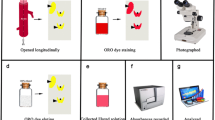Summary
Aortic lesions from African green monkeys fed a cholesterol diet for up to 24 months were studied by electron microscopy. The lesions, grossly classified as fatty dots and fatty streaks consisted of foam cells, increased amounts of interstitial connective tissues and osmiophilic lipid material. In addition, in the interstitial spaces, there were membrane-bound detached cytoplasmic fragments and deeply osmiophilic calcium spherules. The smooth muscle cells had a frayed appearance and bulbous cytoplasmic pseudopod-like processes. Figures suggestive of transition between these cell processes and the detached cytoplasmic fragments were observed. The detached cytoplasmic fragments or ghost bodies often contained lipid droplets, myelin-like figures and calcific material. The process of budding off cytoplasmic fragments was interpreted as a form of clasmatosis enabling smooth muscle cells to eliminate substances which could not be degraded intracellularly. It is proposed that material presented within the ghost bodies may become a nucleation site for calcium salts deposition. Cell necrosis was not a feature observed in this material.
Similar content being viewed by others

References
Balentine DJ (1978) Pathology of experimental spinal cord trauma II. Ultrastructure of axons and myelin. Lab Invest 39:254–266
Blumenthal HT, Lansing AI, Wheeler PA (1944) Calcification of the media of the human aorta and its relation to intimai arteriosclerosis, aging and disease. Am J Pathol 20:665–679
Cooke PH, Smith SC (1968) Smooth muscle cells: the source of foam cells in the atherosclerotic white carneau pigeons. Exp Mol Pathol 8:171–189
Gardner MB, Blankenhorn DH (1968). Aortic media calcification. An ultrastructural study. Arch Pathol 85:397–403
Haust DM, Geer JC (1970) Mechanism of calcification in spontaneous aortic arteriosclerotic lesions in the rabbit. An electron microscopic study. Am J Pathol 60:329–338
Haust MD (1979) Proliferation and degeneration of elastic tissue in aortic expiants from normo-, and hypercholesterolemic rabbits. An ultrastructural study. Exp Mol Pathol 31:169–181
Hoff HF, Gottlob R (1967) A fine structure study of injury to the endothelial cells of the rabbit abdominal aorta by various stimuli. Angiology 18:440–449
Hoff HF, McDonald LW, Hayes TL (1968) An electron microscope study of the rabbit aortic intima after occlusion by brief exposure to a single ligature. Br J Exp Pathol 49:68–73
Joris I, Majno G (1977) Cell-to-cell herniae in the arterial wall. I. The pathogenesis of vacuoles in the normal media. Am J Pathol 87:375–387
Kim KM, Haung SN (1971) Ultrastructural study of calcification of human aortic valve. Lab Invest 25:357–366
Kim KM, Valigorsky JM, Mergner WJ, Jones RT, Pendergrass RF, Grump BF (1976) Aging changes in the human aortic valve in relation to dystrophic calcification. Human Pathol 7:47–60
Kramsch DM, Aspen AJ, Apstein CS (1980) Suppression of experimental atherosclerosis by the Ca++ antagonist lanthanum. Possible role of calcium in atherogenesis. J Clin Invest 65:967–981
Rhadakrishnamurthy B, Ruiz HA, Berenson GS (1977) Isolation and characterization of proteo-glycans from bovine aorta. J Biol Chem 252:4831–4841
Robert B, Szigeti M, Derovette JC, Robert L (1971) Studies on the nature of the “microfibrillar” component of elastic fibers. Eur J Biochem 21:507–516
Scott RF, Jones R, Daoud AS, Zumbo O, Coulston F, Thomas WA (1967) Experimental atherosclerosis in Rhesus monkeys. II. Cellular elements of proliferative lesions and possible role of cytoplasmic degeneration in pathogenesis as studied by electron microscopy. Exp Mol Pathol 7:34–57
Stetz EM, Majno G, Joris I (1979) Cellular pathology of the rat aorta. Pseudo-vacuoles and myo-endothelial hernia. Virchows Arch [Pathol Anat] 383:135–148
Urry DW, Cunningham WD, Ohnish T (1973) A natural polypeptide-calcium ion complex. Biochem Biophys Acta 292:853–857
Veltman E, Backwinkel KP, Themann H, Hauss WH (1975) Electron-enmikroskopische Untersuchungen zur Entstehung von “ghost bodies” in Aorten. Virchows Arch [Pathol Anat] 367:281–288
Author information
Authors and Affiliations
Rights and permissions
About this article
Cite this article
Trillo, A.A. Formation of “ghost” bodies and calcification in experimental atherosclerosis in nonhuman primates. Virchows Archiv B Cell Pathol 38, 127–139 (1981). https://doi.org/10.1007/BF02892808
Received:
Accepted:
Issue Date:
DOI: https://doi.org/10.1007/BF02892808



